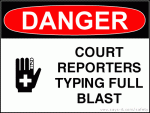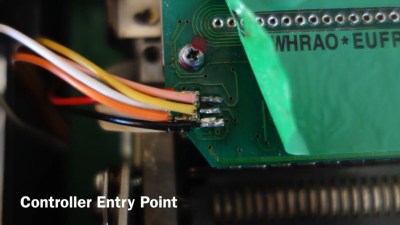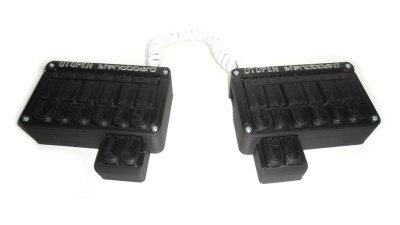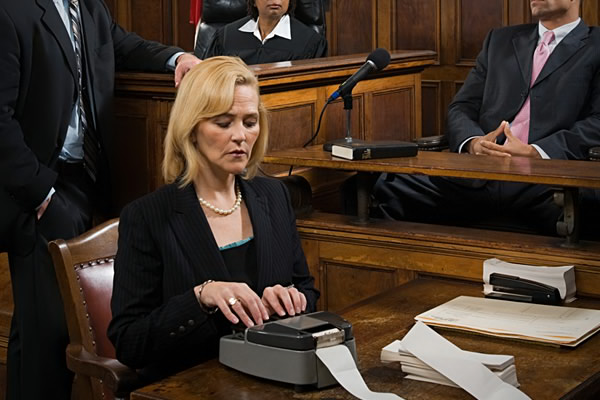What’s the fastest keyboard? Few subjects are as divisive in the geek community. Clicky or squishy? QWERTY or Dvorak? Old-school IBM or Microsoft Natural? The answer: none of the above.
 The fastest normal-keyboard typists (Dvorak or Qwerty) can get around 220 words per minute (wpm) in bursts. That sounds fast, and it’s a lot faster than we type, but that’s still below the minimum speed allowable for certified court reporters or closed captioners. The fastest court reporters clock in around 350 to 375 wpm for testimony. But they do this by cheating — using a stenotype machine. We’ll talk more about stenography in a minute, but first a hack.
The fastest normal-keyboard typists (Dvorak or Qwerty) can get around 220 words per minute (wpm) in bursts. That sounds fast, and it’s a lot faster than we type, but that’s still below the minimum speed allowable for certified court reporters or closed captioners. The fastest court reporters clock in around 350 to 375 wpm for testimony. But they do this by cheating — using a stenotype machine. We’ll talk more about stenography in a minute, but first a hack.
The Hack
[Kevin Nygaard] bought a used Stentura 200 stenotype machine off Ebay and it wasn’t working right, so naturally he opened it up to see if he could fix it. A normal stenotype operates stand-alone and prints out on paper tape, but many can also be connected to an external computer. [Kevin]’s machine had a serial output board installed, but it wasn’t outputting serial, so naturally he opened it up to see if he could fix it. In the end, he bypassed the serial output by soldering on an Arduino and writing a few lines of code.
 The serial interface board in [Kevin]’s machine was basically a set of switches that made contact with the keys as they get pressed, and a few shift registers to read the state of these switches out over a serial connection. [Kevin] tapped into this line, read the switch state out into his Arduino, and then transmitted the correct characters to his computer via the Arduino’s serial over USB. (Video demo) As hardware types like to say, the rest is a simple matter of software.
The serial interface board in [Kevin]’s machine was basically a set of switches that made contact with the keys as they get pressed, and a few shift registers to read the state of these switches out over a serial connection. [Kevin] tapped into this line, read the switch state out into his Arduino, and then transmitted the correct characters to his computer via the Arduino’s serial over USB. (Video demo) As hardware types like to say, the rest is a simple matter of software.
Stenography 101
We’re big keyboard lovers. Maybe one third of Hackaday’s content is typed out on one or another vintage IBM Model M. No self-respecting geek who types for a living doesn’t have a near-religious keyboard preference. [Kevin]’s simple hack brought to our attention that we’ve never covered stenography. (Not steganography.) Frankly, we’re ashamed, and we’re fixing that right now.
 The secret to the speed of steno is the use of a chorded, anatomically designed keyboard with an accompanying phonetic mnemonic shorthand system. Basically, one mashes down keys that correspond to sound of the word, and they’re interpreted according to a mnemonic system with a user-extensible dictionary. In short, it’s machine-assisted typing.
The secret to the speed of steno is the use of a chorded, anatomically designed keyboard with an accompanying phonetic mnemonic shorthand system. Basically, one mashes down keys that correspond to sound of the word, and they’re interpreted according to a mnemonic system with a user-extensible dictionary. In short, it’s machine-assisted typing.
Many words are a single chord, and there are millions of possible chords, so there’s plenty of open space to add one’s own key combinations as the need arises.
But because stenography is a niche market, and because steno machines are designed to be used professionally by closed-captioners and court reporters, stenotype machines cost thousands of dollars. The software that runs them isn’t cheap either and is written for a very specific purpose, and is of course proprietary. In short, the market caters only to professionals, and there’s not much room for the steno enthusiast, until recently.
Plover: Open Software
 Plover is free and open-source stenography software (Github), and is aiming to be the steno gateway drug. Specifically, Plover can turn a normal keyboard (with n-key rollover to support chording) into an emulated steno keyboard through software, allowing entry into the world of stenography for a hundred bucks instead of a few thousand.
Plover is free and open-source stenography software (Github), and is aiming to be the steno gateway drug. Specifically, Plover can turn a normal keyboard (with n-key rollover to support chording) into an emulated steno keyboard through software, allowing entry into the world of stenography for a hundred bucks instead of a few thousand.
Plover will also work with professional stenotypes that support serial output, like the one that [Kevin] modified that sent us down this rabbit hole in the first place. So once you’re hooked on steno, you can use your hard-earned dictionary with improved hardware if you want.
Note that the n-key rollover requirement is binding, and that’s where the $100 comes from. You can easily chord 20 keys on a stenotype machine because each finger has two buttons underneath it, and the chording systems are designed to take extensive use of hitting them two at a time. Some gaming keyboards have sufficient rollover capability, but it’s not a feature that’s demanded by the unwashed masses. In short, n-key rollover is going to cost you a little bit, or you can DIY. (Hint, hint.)
If you’ve played around with alternative keyboards (or just keyboard mappings) before, you’ll know that the Achilles’ Heel is how they handle the command and control characters that your favorite editor or IDE requires you to use. We had this hand-held device that made it nearly impossible to type control-x control-s, so it was goodbye keyboard or goodbye Emacs.
This is not a problem with a steno device, because you can define your own chord mappings. But you don’t have to stop with control characters or even Unicode. Map chords to commonly-used variable names. Map chords to entire flow-control structure skeletons (if-then-else). Think of steno strokes as being typing macros and you’ll get the idea.
The lead behind Plover, [Mirabai Knight], has a ton of info on getting started, including a live browser demo (a must-try!) and a video demonstrating Python (among other things) where you can see how chording works with coding. If you want to see how [Mirabai] transcribes live for clients using Plover and Vim, this video and its side pane are a great peek behind the curtains.
Open Steno Project: The Hardware
The Open Steno Project is an umbrella project on top of Plover to reduce the hardware and theory-learning hurdles. They list three keyboard options.
The Ergodox seems just to be a fancy ergonomic split keyboard, but one that would be particularly suited to stenography.
The Stenosaurus (Silicon-Valley-style empty sign-up page alert) looks sexy. That Stenosaurus is run by [Josh Lifton], the original coder heavyweight behind Plover who recently crowdfunded a batch of lightweight and quiet keyswitches, gives us hope. But hope and $4.35 will buy you a double-pump soy vanilla-whip latte; we like to see work in progress.
 In contrast, the Stenoboard is an open project with actual designs, a 3D-printed case, code, and project examples. The firmware runs on an Arduino. StenoSpeak, an application based on the Stenoboard just won the second prize at the AT&T Connect Ability Hackathon, demonstrating that there’s other reasons to learn steno besides transcription. If you’re looking for some prior art for your own implementation, or a place to jump in and contribute, Stenoboard is a good bet.
In contrast, the Stenoboard is an open project with actual designs, a 3D-printed case, code, and project examples. The firmware runs on an Arduino. StenoSpeak, an application based on the Stenoboard just won the second prize at the AT&T Connect Ability Hackathon, demonstrating that there’s other reasons to learn steno besides transcription. If you’re looking for some prior art for your own implementation, or a place to jump in and contribute, Stenoboard is a good bet.
Conclusion
We’re surprised that we found so few DIY projects on the steno front. The hardware is fundamentally simple, with obvious directions for improvements and personalizations. A stenotype is extremely costly to purchase, but cheap to DIY. The software side is well-established and open source. In short, the ball is set up for a quick hardware field goal.
On Hackaday.io and the blog, there are tons of projects for making improved keyboards — many of them are chorded. But so far all of them ignore the stenotype, the current state of the art in high speed typing that’s been around since the late 1800s. We want to see this change, and we think the tide is high and the planets aligned and so on. Fly, winged monkeys, fly!
















Could you use a MIDI keyboard as a steno input device…?
It seems like you could.
Yes they do that in Italy. It is a slightly modified midi keyboard.
I worked in the Court Reporting/Captioning software industry for many years.
The problem with a steno machine is the mechanics. You must have the option to adjust depth of stroke, resistance, and the trigger point when the keys actually register. You also need to handle stacking and splitting as well.
AWSUM
seems there may be some good, uhm, SYNERGY if you allow CORDS.
(lol)
I don’t know about these stenographers but I suspect that the current fastest keyboard resides on the ISS. Did the Apollo program use keyboards for anything inside the vehicles? If so then my bet is on them as being the fastest keyboards ever.
https://en.wikipedia.org/wiki/Apollo_Guidance_Computer#DSKY
I’m curious just what you think astronauts would need to write so fast/much about?
It occurs to me now that you were just making a wiseass pun on “fastest” referring to velocity relative to a geocentric frame of reference…
Only took ya 10 minutes haha
Interesting he is keeping this alive, most courts have done away with Stenao and now have an 8 track audio recording system with microphones on every location someone is talking. My company actually does the Audio system and DSP programming that we wire up courtrooms for recording and dump it to a crappy windows program (for the record) to record 8 audio channels.
Someone sitting there typing is a very rare thing now days.
Actually no it is not rare. Look up court reporter in you local phone book or look at the NCRA website.
Ha! Phone book!? I almost didn’t catch your joke. ha-ha.
As I said, I rip out their keyboard systems and replace them with 8 track audio recording via a Biamp DSP and 8-16 microphones as well as “for the record” recording software. All federal courts are replacing the rest of them this year. It’s a profession that is dying rapidly.
Will your 8 track audio recording indicated WHO said WHAT? Because that has to be indicated in the transcript. Will it tell people to stop talking at the same time? Does it tell people to slow down, to speak more clearly? Can it give a live output of the proceedings to the attorneys and judge?
Fact is, if you’ve ever seen a transcript done from a tape, you’ll see why live court reporters are in no danger of going away. And your lies about all federal courts replacing court reporters with recording software is just that, a lie. In fact, there are multiple openings online one can apply to right at this moment. The U.S. District Court in the Western District of Tennessee has an opening starting at $81,817 right at this moment, if you’re interested.
It’s still alive and well in television, because it’s the most reliable way to add closed captioning to live, unscripted segments like press conferences and interview shows. (Regular newscasts are usually scripted, and when they are the captioning system is fed the text from the teleprompter.)
This is at the dying edge rather than the bleeding edge of technology… Speech to text processing is growing by leaps and bounds, even if it doesn’t seem like it, it is… And someday, before long, Siri won’t be such a pain in the ass and will handle languages and accents and multiple voices like a breeze and the stenographers job will be that of software. So as much fun as a new (old?) way of typing sounds to learn. I doubt it. Even something like programming doesn’t sound like it would benefit too much beyond the already used macros.
Not sure it’s dying or not. Speech to text is fine unless you’re in public or working near someone else. Even the old clacky keyboards were a distraction. I remember when I got one of the first IBM PCs and stayed up until the wee hours clacking around that old 5250 keyboard my family complained . The one situation the old IBM keyboards were good for was writing flame text. The sound could be quite satisfying.
I had looked for specs and info on the old steno keyboards a while back but the art was obscure and the information protected and I didn’t know the secret handshake that would allow me access. The ability to customize the stroke, angle and position of the keys seems very important.
I wonder if it would be useful to track the context of what you were writing? Writing code would have its set of shortcuts, writing conversationally would have its set.
Thanks for the jumping off point. This has been on my list but backburnered due to lack of available info.
Hi everyone.
If you have not watched the video you should.
it is so cool.
and when she talks the code as she types I think it sounds like a alien talking.
I have a right handed keyboard that I was using for the longest time. (Try finding one of these today.) The problem I was having was I also use my mouse with my right hand and couldn’t get used to using the mouse with my left hand.
Its been a long time since I enjoyed a video this much.
I think it would be so cool to see this kick off.
For some strange reason there is currently not any Wikipedia article about stenography.
Someone might need to address this problem.
Here ya go champ-
https://en.wikipedia.org/wiki/Stenotype
You wrote it so fast, thanks!
Strange. Here in sweden Court proceedings are recorded on a digital file. A secretary writes just basic things on paper, and after the proceeding is done, the secretary will listen to the file and fill in whats missing, and in that case, its easy to rewind and replay or play the tape/file slower if the typist is not fast enough. In some sensitive Court proceedings that is a secret to protect the identity of the victim or witnesses from violence, or to protect sensitive data – for example espionage proceedings (“behind closed doors” as we call it in sweden), its not permitted to record on digital media, then they use a standard analouge tape to record on.
There is microphones in the Court and only one is allowed to speak at one time, and that mic is Active, so Everything is just mixed into a standard stereo recording.
They are also reworking the system to permit sensitive Court proceedings to be recorded digitally using self-encrypting dictaphones instead, and they have a couple of Courts where this are tested to see if that works out.
Closed captioners here in sweden is same here, they have full Control of the source media (movie, etc) and can type in their preferred speed. If its a live transmission, for example a football transmission that must be closed captioned, it will instead be transmitted with a delay so the closed captioner can keep up.
Sadly, where I live in the US they still rely on court reporters, so if you want a record of a particular case you have to contact the court reporter and pay through the nose for a copy (can be in the $100s or higher.) It’s a bit ridiculous to have to shell out such cash for something that’s considered “public records.”
Your attorney can record the case for you while you are in court as long as the recorder is visible to the prosecution (or defendant) and the judge. However, some state laws forbid this practice, and only allow official court recording.
You can try contacting one of the attorneys that worked the case. If it was a family member of yours, and you ask nicely, they may do some pro-Bono work for you and get you a copy.
If it is a Federal case you may be able to go through Pacer. I don’t know if it would be any cheaper.
https://www.pacer.gov/
Wow, talk about pandering to the lowest common denominator. If you can’t keep up then your doing the wrong job…
Live transmissions must be transmitted with a delay anyways, for example for syncing multiple transmission antennas and buffering, and also for a lot other tehnical reasons, for example transcribing between different transmission formats like MPEG4 and such. The delay is about 15-30 seconds when transmitting “live”, sometimes up to one minute, the delay is longer if its a country-wide transmission to ensure Everything is synced up. The good thing here is that this delay is also used by the closed captioner. Normally, the closed captioner only needs to transcribe one sentence at a time, and the closed captioner have lots of Tools to their disposal, for example hearing the sentence 2-3 times.
And typing in 1/2 or 1/3 of talking speed, that can almost everyone do. There more emphasis on a good closed captioning than a fast one, and sometimes the closed captioner must translate aswell. (for example English -> Swedish)
The US courts require that the record be verbatim most other nations do not.
As far as Closed caption I doubt that you are correct. You can not delay a live broadcast long enough for a typist to keep up. There are two types of captioning one is Offline which is for things like movies and sitcoms and online or realtime which is for live events. Some live broadcasts that are scripted will take use the teleprompter feed.
BTW I taught people how to do closed captioning.
I’ve been following plover for a while and the learning curve is a little too steep for me although I’m sorely tempted to try it again with dedicated hardware (QWERTY keyboards are too slanted to work well). As someone who attends university lectures and technical training seminars, a powerful notetaking tool like steno would be awesome and free up time to think about the lecture rather than focus on typing every important point.
Also, even though court reporting is out, there are still many jobs in steno in the form of hearing assistance. My university hires stenographer note-takers to assist deaf students in keeping up with, and participating in, classes that happen in real time – recording and voice recognition tech are probably never going to be better than live captioning from a disabilities perspective.
Classic sci-fi form the pulps age often had space ships or devices operated by keyboard and foot pedals that would put a theater pipe organ to shame. But, a piano keyboard would be cool to play around with. The keywords for your favorite languages can be single keys and oft used phrases are chords with variations as minor, 5ths, and all that. I recall Jef Raskin playing around with the idea in the 80’s – and I mean playing :-) He often did Bach exercises on the KB in his office while he read a tech journal or MacWeek or a book on the music stand. This would sure be a lot easier to realize today.
There’s a book series I love back from those days[1], the Lensmen series by E.E. “Doc” Smith, that has exactly those kinds of controls. As I understand the image he was trying to convey, every single manoeuvring projector[2] on the thing was connected to its own key on a massive bank of controls very similar to a pipe organ and working much the same way, with depression distance controlling power of that particular projector and there being auxiliary controls to modify or control groups. As a purely manual method of controlling propulsion on something that big, it’s certainly an elegant and logical approach.
[1] you can date it by the ubiquitous presence of Bakelite, asbestos and slide rules but lack of any real electronic computers
[2] in the terms of the series, a projector is the term used for an energy based thruster that, as I recall, is like an ion thruster on steroids. I say manoeuvring because these would probably be at least slightly physically separated from the main driving projectors used for acceleration and deceleration.
Stenotype is not stenography : two systems are different.
Stenography is the use of a Stenotype machine to copy verbal information into written information.. A Stenographer is a person that uses a Stenotype machine.
This might be true in the English speaking countries, but at least in Germany, “Stenographie” is what is called “Shorthand” in English, i.e. the use of special symbols and abbreviations to allow to increase the speed of hand-writing. The same use-case but a very different method.
They are similar systems… really closely related. In English, stenography can refer to both stenotype and shorthand. If you want to be pedantic, I’d say that stenography should generally refer to the machine variety nowadays, because it’s a real job unlike written shorthand which is better served as a hobby and a way to keep personal notes. Most journalists just type or record now, so the written practice doesn’t have much value — whereas the skill of typing at over 200 words per minute definitely has its place.
Now, all that being said, I’ve found that within the stenography community, you can differ between the two alternatives by simply saying “machine stenography” for stenotyping systems, and “written stenography” for the shorthand.
Of course, there’s always context. If someone is talking about Gregg and Pitman, you can infer written stenography; if someone is talking about Plover, Phoenix, or Magnum, you can infer machine stenography.
All that to say, you are not wrong, but also not correct. Stenography is the general practice of shorthand, which includes this machine subset.
I’m a learner of Plover on an ErgoDox, I type a little over 100 words per minute, similar to my QWERTY and Norman layout speeds, but the comfort is unmatched and the endurance that I can get out of typing this way is unbelievable. Not to mention that most spelling typos are impossible. (But the typos can be really funny. Like a valid typo for “awesome” is “awful” — just a one key difference. And “goal” can accidentally come out “grade school” if you don’t use the phonetic rules properly)
So far the only big problem I’ve had with stenography is that I end up typing huge walls of text for no reason, because my hands don’t get tired and the speed doesn’t discourage my brain from continuing.
Cheers.
My mother used Gregg Shorthand (So did Della Street). It was called being a stenographer. Stenotype machines came later and court proceedings are transcribed to normal language by typists who read stenography. Business letter and legal docs were often taken down by a personal assistant who knew shorthand and were typed later by them or a general office typist. The Stenopad spiral bound note pad became such a popular format that they are still in all the Office Depots and wherever there is stationary. After the Stenotype machines became common, shorthand was sometimes called pen stenography. I have not seen a stenotype in ages. Courts are using that recording device the court recorder speaks into with the mouth and nose covered.
I thought you all might be interested in seeing exactly how steno works, thanks to the efforts of a self-taught CART provider by the name of Stanley Saki:
http://www.youtube.com/watch?v=62l64Acfidc&feature=youtu.be
ergodox link is broken, this is correct one: https://ergodox-ez.com/
I wish I saw your hack earlier before I bought all the super expensive machine shorthand equipment and software; however I did buy the latest and greatest (Luminex by Stenograph) cation/student machine writer, (minus what they call the bells and whistles) which in short seems to be less ram and no SD slot, which saved me $3,500. I was hoping I could just open it and put more ram in the machine. Any ideas on that?